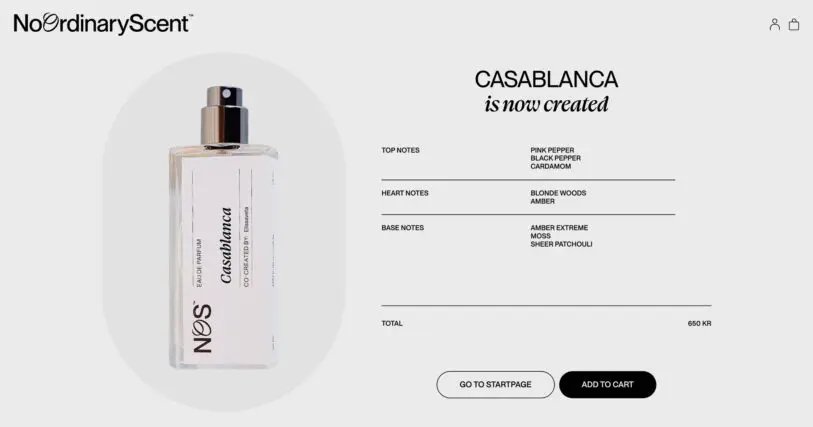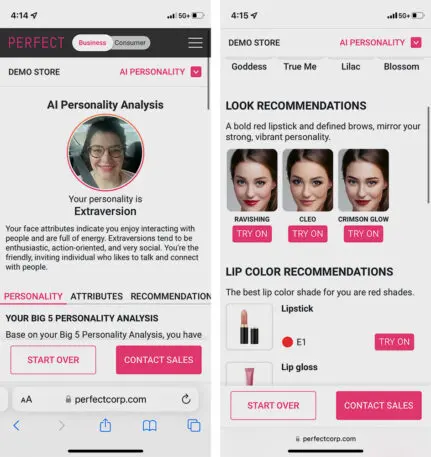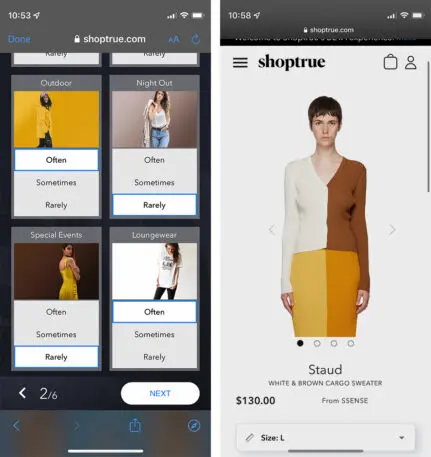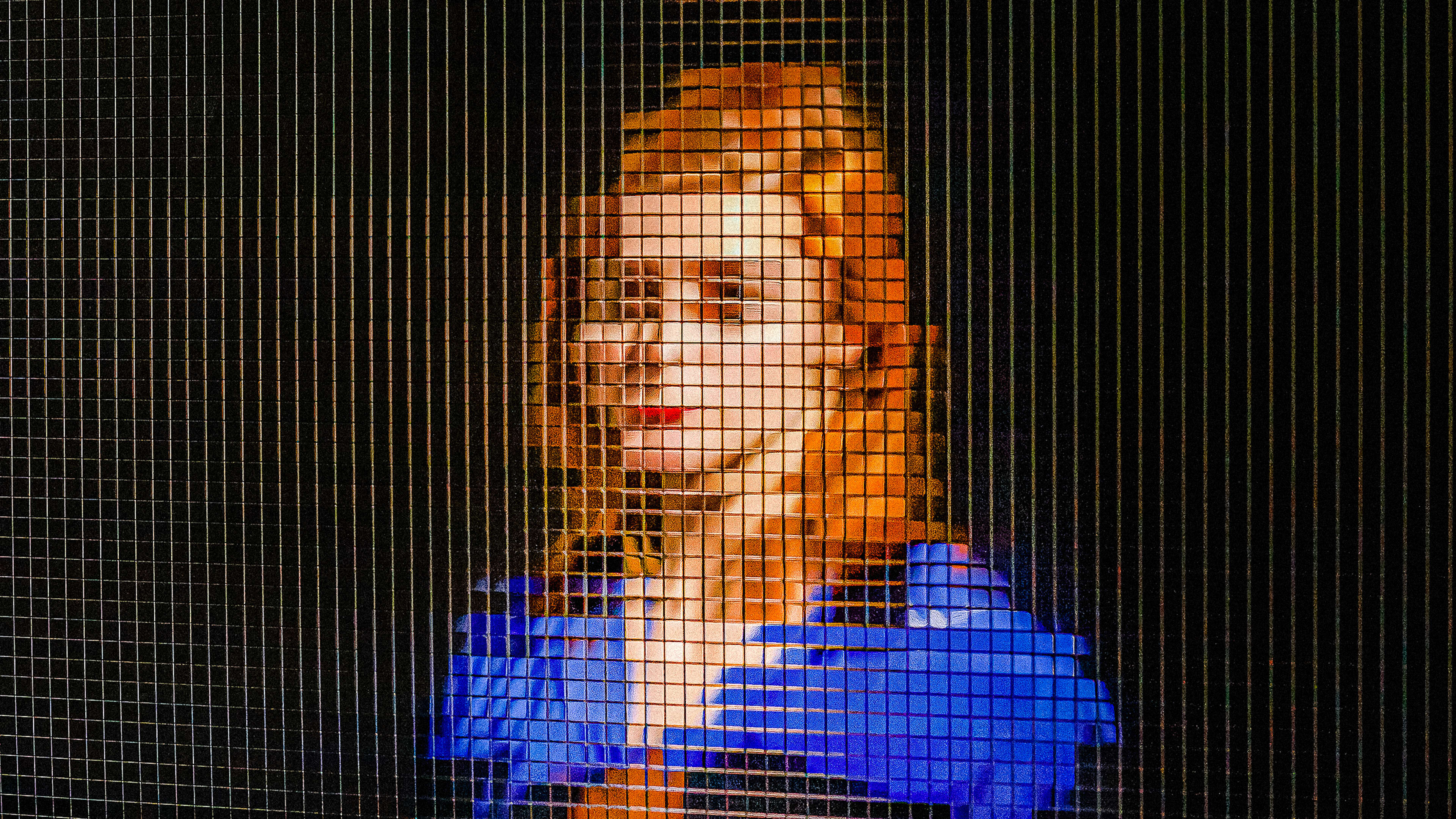How lucky are we to live in an era with so much choice that we can simply outsource it to technology? Need beauty advice? Let AI help. Need a new couch? Let AI help. Need music? Need a perfume? Need a dress? AI can help with those tasks, too.
The digital marketplace has become so saturated that you could arguably consult the AI gods for every single decision you make on the internet. So, that’s exactly what I decided to do. Over the course of one week, I let artificial intelligence tell me what clothes I should buy, the make-up I should wear, and the kind of coffee table I should put in my living room. I listened to music recommended by one kind of AI, then by another kind of AI. I even took an AI personality test to help me pick the best lipstick shade.
I went into this experiment not with the intention to buy, but to see what AI would like me to buy. To get a mood board of what my life would look, feel, and smell like if I let AI take the reins. I approached this investigation with a heavy dose of curiosity and a heavier dose of cynicism. I downloaded half a dozen apps, and visited about as many websites.
I took screenshots every time the AI got it so wrong that I audibly scoffed (often), and I took screenshots every time the AI offered up something I could see myself in (less often). A week in, my phone is packed with screen grabs of garments, patterns, dry shampoos, and perfumes all picked out “especially for me”—and I’m ready to share some personal takeaways.
But first, an index. For furniture, I used Casawire. For music, YouTube Music. For perfumes, EveryHuman and Sommelier du Parfum; and for perfumed candles (yes, AI-enhanced perfumed candles), Scent Lab. For clothes: Shoptrue. And for cosmetics, Glosswire plus a more business-oriented software company called PerfectCorp. What follows is not a review of these apps, so don’t mistake their inclusion for an endorsement.

Takeaway #1: AI is the illusion of uniqueness
One of the biggest selling points that brands like to vaunt is AI’s ability to learn your taste so well that it can fine-tune what they sell you over time. The more time you spend with us, these platforms promise, the more we will get to know you.
During the week-long experiment, I stopped counting the number of times a brand told me that something was curated “especially for me.” For my personal scent, the Stockholm-based fragrance brand No Ordinary Scent turned a trio of images I uploaded on the platform into an Eau de Parfum that was “cocreated” by me. For my personal candle, Scent Lab had me take a 60-second quiz and generated three blends that matched my preferences in order of accuracy, from 84% and 98%. And if I had “commitment issues”—that’s how the brand put it—I could buy mini versions of all three.
I don’t know if I would like any of these scents because I didn’t order any. It may well be that one of these fragrances would propel me right back to Casablanca, where I grew up, and the scent would feel . . . just mine. But when I uploaded three images of places in Casablanca that make me smile (the Hassan II Mosque, the palm tree-lined boulevard we lived on, and a plate of delicious sweets called Cornes de Gazelles), the website generated absurd tags like “curious” and “edgy,” then went on to create a perfume with top notes of pink pepper, amber, and moss—and not a single note of sea salt for the ocean in the photos, or saffron, or anything remotely Moroccan (save for the cardamon).
Regardless of the output, the journey felt transactional and shallow.
According to Meredith Broussard, an associate professor at New York University whose research focuses on algorithmic bias and who recently published the book, More than a Glitch, my disillusion is due to a misalignment between my outsize expectations of AI and the actual potential of it in the realm of commerce. “It’s completely normal to expect AI to feel special, but when you use it, you realize, ‘Oh wait, this is just mundane technology,'” she says.
Reality check: Artificial intelligence is not magic, it’s math. “Very complicated, beautiful math,” clarifies Broussard. And while it’s tempting to imagine that a machine could solve the problem of being human, Broussard reminded me that AI is nothing but statistical processes. It takes massive amounts of data, feeds it into a computer, gets said computer to model various mathematical patterns out of it, and uses those patterns to predict the shade of lipstick someone is going to want.
Speaking of lipsticks: I decided to look for one online, and a short Google search sent me to Perfect Corp‘s website, the one with the AI personality test. After a quick selfie, the website suggested that, based on my facial attributes, I enjoy interacting with people and am full of energy. Naturally, this meant that I should buy a bold red lipstick called “Ravishing” to “mirror my strong, vibrant personality.” (I should note that I like people only in moderation and am definitely not full of energy.) I liked the proposed lipstick, but I was so put off by the blatantly manipulative process that I couldn’t bring myself to purchase it.

Takeaway #2: AI doesn’t actually help you make decisions
Decision paralysis is a distinctly 21st century problem, and it has found a 21st century solution in artificial intelligence. Or has it? According to a recent study by Oracle, which surveyed more than 14,000 business leaders, AI has led to a distressing level of data overload. 74% of respondents said the number of decisions they have to make every day has increased more than tenfold over the last three years, and 72% believe the majority of data available is only truly helpful for IT professionals or data scientists who can interpret and leverage the insights in meaningful ways. I’m no data scientist, but the predicament felt awfully familiar.
The lipstick market is expected to reach $12.5 billion by 2026. That’s millions of lipsticks currently sitting in warehouses, cargo ships, and on fancy glass shelves. The same applies to almost every category of things you can buy (at least in the U.S.). Log into Netflix and you’ll have more than 17,000 titles titles to choose from. Try to buy a couch online, and your head will explode. If AI could help me narrow down my options, why shouldn’t I let it?
As someone who hates to shop, I was excited by Shoptrue’s mission: to be the Netflix of fashion. The website, which launched in November 2022, uses artificial intelligence to curate a personalized shopping list based on your taste, budget, and fit, so you no longer have to spend hours spelunking for that perfect puffer coat.
Except, my shopping experience was just like being at the mall, with an additional layer of self-loathing every time AI recommended a tight-fitting garment. That color-block sweater that Shoptrue put forward looked gorgeous on the size 0 model, but it most definitely wouldn’t look gorgeous on me, in no small part because the website didn’t bother to ask for my size or even my body shape before it started choosing tops.
Instead, it asked for the way I dress in a typical month, the brands I usually wear, the words I’d use to characterize my style, and the colors and patterns I like to wear. When the company launched, the founders told Fast Company that the algorithm will end up learning your fit and size preferences over time, and then will recommend items that are more likely to be flattering. This may become the case eventually, but who has the time to wait?

Takeaway #3: AI will never know the real you
There’s something about a brand selling the idea that something was created “just for you,” that lights up the ego like a Christmas tree. Research has shown that humans like to be seen as individuals rather than as part of a herd. We like monogrammed napkins and personalized Pandora bracelets. We want to feel special. So when a brand offers you bait, you bite. Except in my experience, bait is never as sweet as you expect.
This particular problem is bigger than AI. Broussard says the internet has sold us a lie that targeted advertising could give us exactly what we desire. “The idea that somehow shopping could be personalized to give you what you want is also not entirely true,” she says. “It’s not actually going to make you happy, it’s just going to show you things that you are likely to buy based on what people like you bought before, and that’s not the same as joy, that’s just commercial transactions.”
One of the first platforms I tried as part of my experiment was Casawire, which launched in December 2022 (though some AI features are yet to roll out.) The service bills itself as Tinder but for furniture, a premise I found preposterous enough to test. The rules are generally familiar: Swipe left if you like whatever’s on your screen, swipe right if you don’t. The swipe direction is the opposite of Tinder’s, which I found immensely confusing even though I only spent a week on Tinder before meeting my now-husband (I suppose that algorithm worked for me).
The first day I used Casawire, I hated almost every piece of furniture I saw. No matter, I thought, the algorithm doesn’t know me yet. The second day I used it, I hated almost every piece of furniture I saw. The third time I used it . . . you know where this is going. (The app only had 75 brands when I tested it, so it’s possible there just wasn’t enough variety). Regardless, the platform continually suggested pieces from a brand that I swiped right on (i.e. disliked), which felt like breaking the most basic promise of AI.

Takeaway #4: AI has killed the art of discovery
Throughout my weeklong experiment, I realized that as much as AI likes to pretend it knows you, it simply doesn’t. But there was one exception, and that was the world of music streaming.
For the sake of my experiment, I put my existing Spotify subscription on hold to test out YouTube Music, mostly so I could start with a clean slate. Before I’d even listened to a single song on the platform, I felt seen (probably because YouTube is owned by Google, and Google already knows everything there is to know about me). There it was waiting for me: the French pop from my teenage years and the Americana folk from my recent New York years. The classical music, the soundtracks I’d never heard before but love writing to. Even the Moroccan artists I listened to when I was young were in my queue, with new releases that brought me so much joy.
And then the spell broke. After I chose something classical, I let the shuffle run with it all evening. Within a day or two, my entire home page was nothing but classical music, and every other part of me vanished from the screen. The AI knew me too well for my own good; I was stuck in a feedback loop.
As I look at the mood board of my life—bold red lipstick, tobacco-scented candle, classical music on repeat—I did see parts of myself in the items AI presented, but I can’t shake off the illusion of it all. How many others have been presented with similar versions of my lipstick, and my tobacco-scented candle?
It was a failed experiment, but despite my lackluster results, there’s a certain joy and value in the experience of working with technology to cocreate the stuff in our life. It’s the same joy that you get when technology helps you discover something new that you truly love, be it a perfume or a person who made you smile on a dating app.
But in the end, I found that shopping with AI felt a bit like reading a horoscope: Believe the bits you like, ignore the bits you don’t. Maybe I am a textbook human after all: I want to feel special, and AI only made me feel like a data point.
Recognize your brand’s excellence by applying to this year’s Brands That Matter Awards before the early-rate deadline, May 3.
